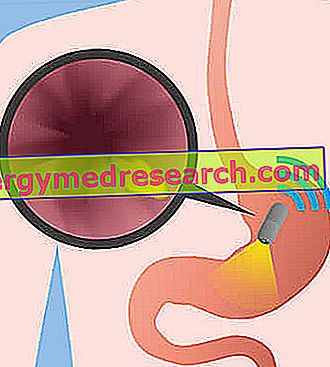Generality
Ptosis is the term by which doctors indicate any downward movement of one or more parts of an organ .
Ptosis depends on the force of gravity and can be a consequence of aging, obesity or neurological, muscular or neuromuscular conditions.

The most known and widespread type of ptosis is palpebral ptosis, also called drooping eyelid or blepharoptosis.
What is ptosis?
Ptosis is the medical term for any downward movement (prolapse) of one or more parts of an organ.
The word "ptosis" derives from " ptosis " ( πτῶσις ), an ancient Greek word meaning "fall".
Causes
Depending on the force of gravity (which induces the downward shift), episodes of ptosis can be the consequence of aging, obesity or neurological, muscular or neuromuscular conditions.
Types
There are numerous types of ptosis.
The most known and widespread type is, certainly, the palpebral ptosis.
However, in this context, also worthy of mention are: renal ptosis, gastric ptosis, intestinal ptosis, visceral ptosis, mammary ptosis and cardiac ptosis.
PALOSBAL OR PALPEBRA DROPPING PTOSI
Also known as drooping eyelid or blepharoptosis, eyelid ptosis is the abnormal lowering of one or both upper eyelids .
This particular ocular condition can be a congenital problem - therefore present from birth - or a problem that appears throughout life, due to some specific reasons.
The palpebral ptosis that occurs from birth takes the name of congenital palpebral ptosis, while the palpebral ptosis that it only compares to a certain age is known as acquired eyelid ptosis .
The causes of palpebral ptosis are numerous.
Congenital forms can derive from:
- Poor development of the muscles that lift and close the eyelid (levator muscle, eye orbital muscle and upper tarsal muscle);
- Genetic / chromosomal defects;
- Congenital neurological dysfunctions;
The acquired forms, instead, can be a consequence of:
- Aging. As we age, the muscles of the human being weaken, including the muscles that govern the opening and closing of the upper eyelids;
- Separation or stretching of the levator of the levator muscle (of the eyelid);
- Cataract interventions. In such situations, palpebral ptosis is a surgical complication;
- Ocular trauma affecting the muscles responsible for the movement of the upper eyelids (eg: paralysis of the upper tarsal muscle);
- Neurological disorders affecting the nerves controlling the eyelid muscles (eg: oculomotor nerve paralysis, Horner syndrome, stroke, etc.);
- Neuromuscular diseases, such as myasthenia gravis ;
- Ocular tumors;
- Systemic diseases, such as diabetes;
- Taking high doses of opioid drugs (morphine, oxycodone, etc.);
- Drug abuse (eg heroin).
The typical sign of palpebral ptosis is the failure of one or both upper eyelids.
The failure can be barely perceptible (less serious cases) or particularly evident (more serious cases). In the presence of severe palpebral ptosis, both the pupil and the iris are covered (from the eyelid) and the patient may experience vision problems.
In children, eyelid ptosis is a condition that is associated quite frequently with amblyopia (lazy eye) or strabismus .
The diagnosis of eyelid ptosis and its triggering causes may require the execution of numerous tests, including tests for the assessment of the muscular capacity of the eyelids, tests for the evaluation of the palpebral nerve functions, etc.
The treatment of the eyelid ptosis is based, mainly, on two elements: the triggering factors - this explains why their precise identification, during the diagnosis phase, and the severity of the lowering of the eyelid is important.
- Congenital palpebral ptosis. If mild, periodic medical observation is sufficient.
If particularly severe, it represents a typical ideal condition to resort to blepharoplasty surgery.
- Eyelid ptosis due to aging. The above is valid: if slight, periodic observation by the doctor is sufficient; if serious, on the other hand, it requires the intervention of blepharoplasty.
- Eyelid ptosis due to myasthenia gravis . Myasthenia gravis is a disease for which there is no specific treatment, but only symptomatic therapies (ie focused on treating symptoms). To reduce palpebral ptosis induced by myasthenia gravis, the following are useful: pyridostigmine and neostigmine cholinesterase inhibitors, prednisone and derivative corticosteroids and azathioprine, cyclosporine and methotrexate immunosuppressive drugs.
The prognosis in the case of eyelid ptosis depends on the severity of the triggering causes: the condition that causes the lowering of the eyelids is less serious and more easily treatable, the higher the probability of improving the appearance of the affected eyelid or eyelids.
| Types of palpebral ptosis (the distinctive criterion is the triggering cause) | Short description |
| Myogenic ptosis | It is due to a weakening of the elevator, orbicular and upper tarsal muscles. It mainly concerns subjects with myasthenia gravis and myotonic dystrophy. |
| Neurogenic ptosis | It is due to a malfunction of the nerves that control the levator muscle of the upper eyelid. It is typical of those suffering from oculomotor nerve paralysis. |
| Aponeurotic ptosis | It is a consequence of aging or eye surgery, which has weakened the muscular apparatus of the upper eyelids. |
| Mechanical ptosis | It may appear following the presence of a neurofibroma, a hemangioma or post-inflammatory or post-surgical scarring. |
| Traumatic ptosis | It is due to traumas that affect the health of the levator muscle and the nerves that control it. |
| Neurotoxic ptosis | It is the result of poisoning. Often, it is accompanied by: diplopia, dysphagia, muscular paralysis, respiratory failure and tendency to suffocation. |
RENAL OR NEPHROPTOSIS PTOSIS
Renal ptosis, or nephroptosis, is the abnormal lowering of one or both kidneys, which occurs when the person concerned moves from the supine position to the standing position.
Doctors are keen to point out that a renal ptosis is considered as such when the kidneys, moving downwards, make a movement of at least 5 centimeters or at least two vertebral bodies.
Renal ptosis is particularly widespread in the female population (especially among women of thin build), it affects the right kidney more frequently (although 20% of cases are bilateral) and seems to affect more than 20% of young people.
Currently, the precise causes of nephroptosis are unknown. According to some experts, the problem in question would be due to a weakening of the so-called renal fascial complex (or renal fascia ). The renal fascial complex is a collection of serous leaflets that delimit and maintain the kidneys in place.
In most cases, renal ptosis is asymptomatic, ie it does not cause any symptoms. More rarely, it is responsible for: flank pain, nausea, hypertension, chills, hematuria and / or proteinuria.
Following the obstruction that the kidney makes to the damage of the renal tract, the pain in the side has the particularity of diminishing, if the patient lies down.
In general, the diagnostic procedure for the detection of renal ptosis includes an accurate physical examination and intravenous urography. In doubtful cases, it may be necessary to perform a renal scintigraphy, an abdominal CT scan and / or an abdominal ultrasound.
Today, the only cases of renal ptosis treated are those that are symptomatic. For patients who do not experience any kind of disorder, in fact, the so-called medical observation is opted for.
The treatment of the symptomatic cases of renal ptosis consists of the operation of laparoscopic nephropexis . Laparoscopic nephropexis is a surgical procedure, performed in laparoscopy, which involves replacing the kidney in its natural location and fixing it, through sutures, to some neighboring anatomical structures.
GASTRIC OR GASTROPTOSIS PTOSIS
Gastric ptosis, or gastroptosis, is the abnormal displacement of the stomach in the lower portion of the abdomen.
Generally, those suffering from gastric ptosis suffer from problems with digestion, pain in the abdomen and constipation, but cannot be considered life threatening.
More common in the female population, gastric ptosis can be a condition present since birth ( congenital gastroptosis ) or a condition that arose at some point in life ( acquired gastroptosis ).
Gastroptosis depends on a weakening of the anterior abdominal wall, which, under normal conditions, also has the task of keeping the abdominal organs in place.
In cases of congenital gastroptosis, the weakening of the abdominal wall depends on the inappropriate development of the muscles that make it up; in cases of acquired gastroptosis, on the other hand, the weakening of the abdominal wall can have different causes, including:
- A sudden loss of abdominal fat, following a strict diet;
- Abdominal surgery. In these situations, gastroptosis is a surgical complication;
- Childbirth;
- Vitamin and / or protein deficiencies.
Depending on the extent of the lowering, doctors distinguish gastric ptosis into: first-degree gastroptosis, second-degree gastroptosis and third-degree gastroptosis.
Gastroptosis is first grade in which the stomach, after its downward movement, resides 2 centimeters above the so-called comb crest of the iliac bone.
Gastroptosis in which the stomach is brought to the same level as the comb crest of the iliac bone is second-rate.
Finally, the gastroptosis in which the stomach has lowered to the point of being below the comb crest of the iliac bone are third-degree.
Usually, only third degree gastroptosis is symptomatic; in such situations, the symptoms appear more frequently after meals.
To diagnose a condition such as gastric ptosis, the following are essential: medical history, physical examination with palpation of the abdomen and abdominal ultrasound.
The treatment of gastroptosis is usually conservative; the use of surgery, in fact, is reserved for a few cases, in this case to the most serious ones that do not respond to conservative treatment.
Conservative therapy for the treatment of gastric ptosis includes:
- The use of a special abdominal containing band (it is a sort of waistband);
- Physiotherapy exercises, for strengthening the anterior abdominal wall;
- Painkillers;
- Appropriate diet, divided into many small meals.
VISCERAL OR VISCEROPTOSIS PTOSIS
Visceral ptosis, or visceroptosis, is the prolapse of abdominal viscera. Therefore, in those suffering from visceral ptosis the viscera of the abdomen are located in a different position from the natural one, to be more precise below.
More common among women, visceroptosis is usually the consequence of multiple pregnancies or a sudden loss of weight, due for example to serious pathologies. These two conditions - multiple pregnancies and sudden weight loss - cause visceral ptosis, because they induce a loss of abdominal muscle tone and a relaxation of the ligaments, which hold the abdominal viscera.
Typical symptoms are: loss of appetite, heartburn, constipation or diarrhea, abdominal distention, headache, dizziness, stomach pain and lack of sleep.
Treatment of visceral ptosis is usually conservative. The use of surgery, in fact, is reserved for a few cases, generally the most serious.
Conservative therapy for visceral ptosis includes:
- The application of a containing bandage, around the abdomen, or, alternatively, the use of a special abdominal band with a containing effect;
- Rest from heavy physical activities (eg: lifting weights);
- Physiotherapy exercises, for strengthening the abdominal wall;
- Appropriate diet, divided into many small meals.
INTESTINAL OR ENTEROPTOSIS
Intestinal ptosis, or enteroptosis, is the prolapse of the intestine. In fact, it is a special case of visceral ptosis, in which the affected abdominal bowel is only the intestine.
In light of this, due to the causes, symptoms and treatment, the reader can refer to the previous sub-chapter, related to visceroptosis.
PTOSI MAMMARIA
Breast ptosis is the failure, with subsequent downward movement, of a woman's breast.
Mammary ptosis is a natural consequence of aging, to which various factors can contribute, including:
- Cigarette smoke;
- A high number of pregnancies;
- The constant practice of physical activities that cause the movement of the breast in several dimensions of space;
- A high body mass index;
- The marked and sudden loss or gain in weight.
The breasts of women who develop mammary ptosis change at least from 3 points of view: position, volume and size.
Mammary ptosis does not cause symptoms and is not life-threatening. However, it is still a condition of considerable medical interest, as its appearance involves, in several women, a certain aesthetic discomfort.
Aesthetic surgeons measure the severity of breast ptosis in 4 degrees: grade I, grade II, grade III, and grade IV.
Grade I corresponds to episodes of mild breast ptosis; grade II for episodes of moderate breast ptosis; grade III in episodes of advanced breast ptosis; finally, grade IV for episodes of severe breast ptosis.
Currently, the most common treatment to improve the appearance of a breast with breast ptosis is the plastic surgery known as mastopexy . Mastopexy is breast lift .
HEART OR CARDIOPTOSIS PTOSIS
Cardiac ptosis, or cardioptosis, is the displacement of the heart downwards.
Due to a relaxation of the structures that keep the heart in its natural location, cardiac ptosis is often associated with heart disease and tachycardia.



